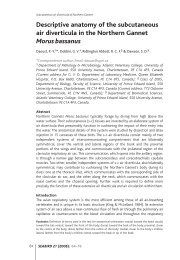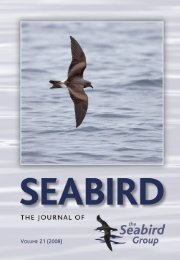You also want an ePaper? Increase the reach of your titles
YUMPU automatically turns print PDFs into web optimized ePapers that Google loves.
2001 Body mass reduction in Kittiwakes 175<br />
total energy expenditure. Thus, it is tempting to speculate that a reduction in<br />
BMR during the chick rearing period may be a mechanism that minimises<br />
maintenance costs, which in turn enables the adult birds to allocate more energy<br />
to chick-growth without greatly increasing their total energy consumption. Such<br />
a mechanism will be advantageous in situations where both food and time are<br />
limiting resources and costs are associated with increasing the food intake. In<br />
some species of birds, a reduction in RMR has been found to compensate for<br />
increased activity. Deerenberg et al. (1998) manipulated the workload of<br />
individual Zebra Finches by experimentally increasing the amount of activity<br />
(number of hops) required to get access to food. <strong>The</strong>y found that for individuals<br />
with a high workload daily energy expenditure and daily food intake were lower<br />
than for individuals with a low workload. <strong>The</strong> difference was larger than could<br />
be explained by a reduction in the body mass of the high-workload individuals.<br />
Deerenberg et al. (1998) concluded that the high-workload individuals<br />
compensated (or even over-compensated) by behaviourally increasing their<br />
efficiency and by decreasing their RMR, both during the night and the inactive<br />
hours of the day. Although this study did not explain the physiological<br />
mechanis ms underlying the reduction in RMR, it did show that even though the<br />
birds had ad libitum access to food they compensated for the increased activity<br />
by reducing their body mass and RMR rather than increasing their food intake.<br />
A similar change in RMR was found in male White-crowned Sparrows<br />
Zonotrichia leucophrys gambelii with varying testosterone levels (Wikelski et<br />
al. 1999). Males (both intact and castrated) with testosterone implants showed<br />
an increased activity level, but a decrease in both body mass and RMR,<br />
compared with pre-implantation values.<br />
<strong>The</strong>se findings of a body mass related reduction in RMR in Zebra<br />
Finches and White-crowned Sparrows in connection with an increase in activity,<br />
resemble our finding of a reduction in BMR in female Black-legged Kittiwakes<br />
during the chick-rearing period. One can speculate that whereas female<br />
mammals must mobilise the metabolic machinery in order to support the<br />
growing foetus and later the endogenous milk production, birds, in contrast,<br />
seem to be able to slow down their metabolic intensity at rest as a compensation<br />
for the increased workload during reproduction. However, the question still<br />
remains as to whether Black-legged Kittiwakes lose body mass because of<br />
limited food and time resources, or whether there are costs associated with<br />
increasing food intake, such as increased predation risk, which exceed the costs<br />
of losing weight. Obviously there must also be costs associated with reducing<br />
metabolic rate at rest, otherwise it would have been energetically advantageous<br />
to maintain a constant low metabolic rate. A reduction in body mass may<br />
involve a depletion of body reserves that normally serve as insurance against<br />
starvation (Lima 1986), and a reduction in BMR may result in damage to the








